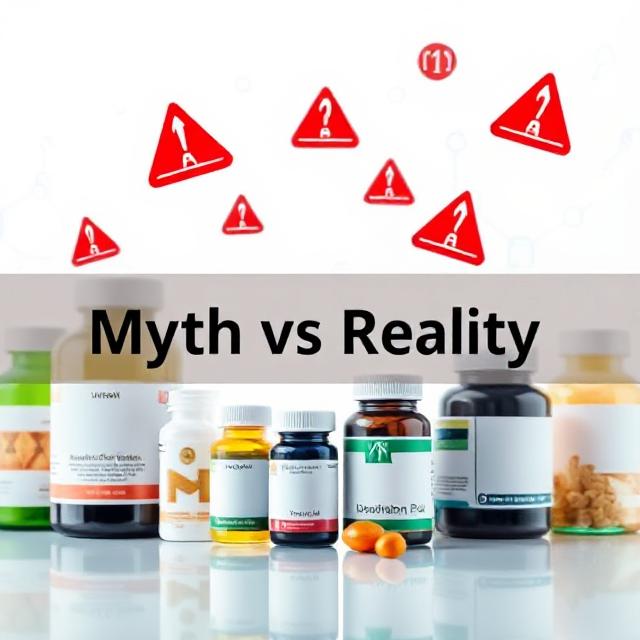
Table of Contents
Supplement Toxicity Myths Debunked
Supplements are marketed as safe, natural boosters for everything from energy to immunity—but how safe are they, really? While many people assume that “more is better,” others live in fear of overdosing on vitamins or minerals. The truth lies somewhere in the middle.
In this deep dive, we’ll debunk the most persistent supplement toxicity myths, break down what the science actually says about dosages and timing, and help you separate real risks from pseudoscientific panic.
Understanding supplement toxicity myths isn’t just about avoiding harm—it’s about optimizing benefit.
🧠 Myth 1: “Natural Supplements Can’t Be Toxic”
This is one of the most dangerous assumptions in the health world. Just because something is derived from nature doesn’t mean it’s harmless in high amounts.
Reality:
- Vitamin A, especially in the retinol form, can cause liver damage and neurological issues in excessive doses.
- Iron supplements, when overused, can lead to oxidative stress and organ toxicity.
- Herbs like kava or comfrey can damage the liver when taken long-term or without supervision.
Rule of thumb: Natural ≠ safe at all doses.
Even plant-derived compounds can overwhelm liver detoxification systems or accumulate in tissues if not metabolized properly.
⚖️ Myth 2: “You Can’t Overdose on Water-Soluble Vitamins”
Water-soluble vitamins like B-complex and vitamin C are often promoted as “flushable”—your body supposedly eliminates the excess in urine. While this is partially true, it’s not the whole story.
Reality:
- Excess vitamin B6 (pyridoxine) over time can cause nerve damage and neuropathy.
- Over-supplementing vitamin C can lead to kidney stones in susceptible individuals.
- Even niacin (B3) in high doses can trigger liver toxicity and flushing reactions.
Just because your urine is neon yellow doesn’t mean your kidneys are fine with what you took.
🕒 Myth 3: “Toxicity Happens Only with Long-Term Use”
Many believe that supplement toxicity is something that happens slowly over years. But acute toxicity can occur even from short-term misuse.
Reality:
- Calcium + vitamin D + magnesium taken together in megadoses can cause arrhythmias or kidney issues within days.
- Pre-workout stacks with excessive caffeine, yohimbine, or synephrine can raise blood pressure dangerously high within hours.
- Fat-soluble vitamins (A, D, E, K) can accumulate even over a single week of aggressive stacking.
Toxicity is often a matter of stack interaction, not just duration.
📊 Myth 4: “RDAs Are Maximums You Shouldn’t Cross”
The Recommended Dietary Allowances (RDAs) are often mistaken as hard safety limits—but they’re not designed that way.
Reality:
- RDAs reflect the minimum amount needed to avoid deficiency in most people, not the maximum safe amount.
- The Tolerable Upper Intake Level (UL) is the real safety threshold—and it varies based on health status, absorption, and genetics.
- Some therapeutic doses (e.g., for magnesium or vitamin D) intentionally go above the RDA under medical supervision.
RDA = baseline. UL = ceiling. Toxicity = context.
Bioavailability, delivery format, and individual tolerance all matter more than a generic number on a bottle.
🔁 Myth 5: “You Should Take Everything Daily”
Many supplement users build a daily habit based on repetition, not need. But not all compounds need to be taken daily—and some shouldn’t.
Reality:
- Zinc, when taken daily for too long, can induce copper deficiency.
- Fat-soluble vitamins often store in tissues and don’t require daily input.
- Adaptogens and nootropics like rhodiola or bacopa often perform better when cycled.
Think therapeutic window, not habitual routine.
Cycling allows your receptors to reset, your organs to detoxify, and your body to stay responsive.
⚠️ Myth 6: “More is Better for Mental Performance”
This is a classic biohacker trap. The belief is that doubling your stack will double your focus.
Reality:
- Overuse of choline donors like Alpha-GPC or CDP-choline can cause mood instability or brain fog.
- Caffeine loses its effectiveness past 200–400 mg and can impair memory at high doses.
- High-dose omega-3s may thin the blood too much or impair immune resilience.
The best cognitive function comes from precision, not excess.
Your mitochondria, neurotransmitters, and brainwaves operate in balance—overstimulating one gear can disrupt the whole machine.
🧬 Myth 7: “Supplements Are Always Safer Than Medication”
This belief stems from the assumption that because supplements aren’t prescription drugs, they must be gentler.
Reality:
- Many supplements interact with medications, especially blood thinners, antidepressants, and antihypertensives.
- Some herbal supplements, like St. John’s Wort, alter liver enzymes that regulate drug metabolism.
- Unlike medications, supplements are often not standardized, meaning dose consistency can vary across brands.
Safety depends on context, sourcing, and awareness—not category.
🧠 Real Questions to Ask About Any Supplement
Instead of fearing supplements or overusing them, ask:
- Why am I taking this?
- Is it based on a test, a symptom, or social media hype?
- Is the dose aligned with my body weight and health status?
- Does it interact with other supplements or medications I’m using?
- Am I cycling this compound or taking breaks?
- Is this water- or fat-soluble?
- This changes how and when to take it.
- Have I tracked any results or changes?
- Energy, digestion, mood, sleep, biomarkers?
✅ Final Takeaway: Precision Over Panic
Toxicity isn’t about fear—it’s about biointelligent strategy. Supplements can support brain health, energy, and cognition—but only when used in sync with your body’s signals, your life rhythms, and actual scientific principles.
Don’t demonize supplements.
Don’t worship them either.
Respect the dose. Respect the cycle. Respect your biology.